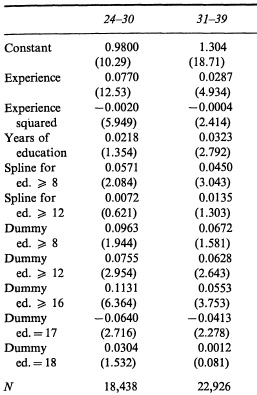
When economists measure the return to education, they usually assume that all years of schooling increase earnings by the same percent. A standard regression would be:
log (Earnings in dollars)= a + b*(Education in years)
where b is the measured return to education. If b=.06, this means that an extra year of education boosts your earnings by 6%.
In reality, however, the typical year of education pays very little. Most of the financial reward of education comes from finishing degrees. Since diplomas used to be written on sheepskin, this finding is known as the “sheepskin effect.”
Researchers usually interpret sheepskin effects as signaling. If finishing your last year of college sharply boosts your income, the reason probably isn’t that colleges withhold the financially lucrative material until your senior year.
What I didn’t know until recently is that the sheepskin effect declines with age. Belman and Heywood’s “Sheepskin Effects by Cohort: Implications of Job Matching in a Signaling Model” (Oxford Economic Papers, 1997) finds that sheepskin effects are large for 24-30 year-olds, moderate for 31-40 year-olds, and small thereafter. Their earnings regressions for 24-39 year-olds:
The middle school sheepskin effect is “Dummy ed. ≥8,” the high school sheepskin effect is “Dummy ed. ≥12,” and the college sheepskin effect is “Dummy ed.≥16.” In plain English, finishing high school pays a 7.6 percentage-point bonus in your twenties, and a 6.3 percentage-point bonus in your thirties. Finishing college, similarity, pays 11.3 extra percentage points in your twenties, and 5.5 percentage-points in your thirties. This is all over and above the modest per-year payoff.
Now see what happens later in life:
The sheepskin effect for high school graduation falls to 4.4 percentage-points in your forties, 1.9 percentage points in your fifties, and 2.4 percentage points in your sixties. For college, the analogous bonuses are 2.7%, 1.8%, and a very imprecisely estimated 8.8%. None of these are statistically significant, but by wage regression standards, they’re still sizable.
What does all this mean? If you’re eager to dismiss the signaling model, you’ll hail the qualitative result: Signaling effects decline over time. If you focus on the actual quantities, however, you’ll reach a different conclusion: Large signaling effects endure for decades.
Even more importantly, the fact that the sheepskin effect is front-loaded means that sheepskin effects are a large share of the present value of the return to education. During your twenties, the return to college is roughly 50% sheepskin, 50% other. In your thirties, that breakdown falls to about 25% sheepskin, 75% other. But since you earn the big sheepskin effects first, those years count more. For example, with a 5% interest rate, a 24-year-old can expect the sheepskin effect to provide 38% of the expected payoff of college during his twenties and thirties. (My calculations).
Does the labor market ever see through mere credentials? In the long-run, it usually does. But the glass is half empty: The long-run takes decades to arrive. By the time the market sees through mere credentials, the merely credentialed have already reaped large rewards. They never have to pay them back. And all you need to do to join this gravy train is finish your degree.

READER COMMENTS
Glen S. McGhee FHEAP
Jan 20 2012 at 6:36pm
This is only the beginning.
Even worse are the observations of Lisa Kahn, The Long-Term Labor Market Consequences of Graduating
from College in a Bad Economy.
http://mba.yale.edu/faculty/pdf/kahn_longtermlabor.pdf
You need to look at those purported gains as well – they only accrue in a good economy, when job incumbents ride upward on a career ladder. Precious little of this when retirees lose their retirement funds, and hand onto jobs forever.
c141nav
Jan 20 2012 at 6:40pm
This really speaks to me. I earned my first master’s degree in my early 20’s. Got my MBA in my 40’s. It was worthless. I couldn’t get a job anywhere near my experience/education qualifications after I retired from the USAF. Think about my qualifications! Yet job offers were just above minimum wage. PLUS any income would be at marginal taxation. It wasn’t worth my time for most jobs.
Phil
Jan 20 2012 at 9:25pm
But the lasting effect later in life might not be the sheepskin effect per se. It might just be that the sheepskin effect got you onto a better career path earlier in life.
Imagine that the sheepskin gets you into a job stream that pays 10% more to start, and that everyone gets a raise of 10% per year. Then the sheepskin effect in your 50s and 60s will appear to also be 10%, even though the bias all happened 30 or 40 years ago.
If that’s the case, the fact that the effect drops with age, rather than staying constant, would show that employers are correcting for their initial bias over the years. That’s the case even if the effect doesn’t drop as far as zero.
Hume
Jan 21 2012 at 2:28am
The irony, of course, is that Bryan Caplan–the nerd of nerds–recommends that everyone else take the BLUE pill. Ignorance is bliss, after all.
roystgnr
Jan 21 2012 at 12:24pm
Were these statistics collected by randomly assigning two halves of the same college juniors population into the “you’re required to graduate” half” vs the “you’re required to drop out” half? Because if not, then I’d like to know what other mechanism is being used to factor out the enormous selection bias involved in studying two groups who decide to graduate or “decide” to drop out on their own.
Comments are closed.